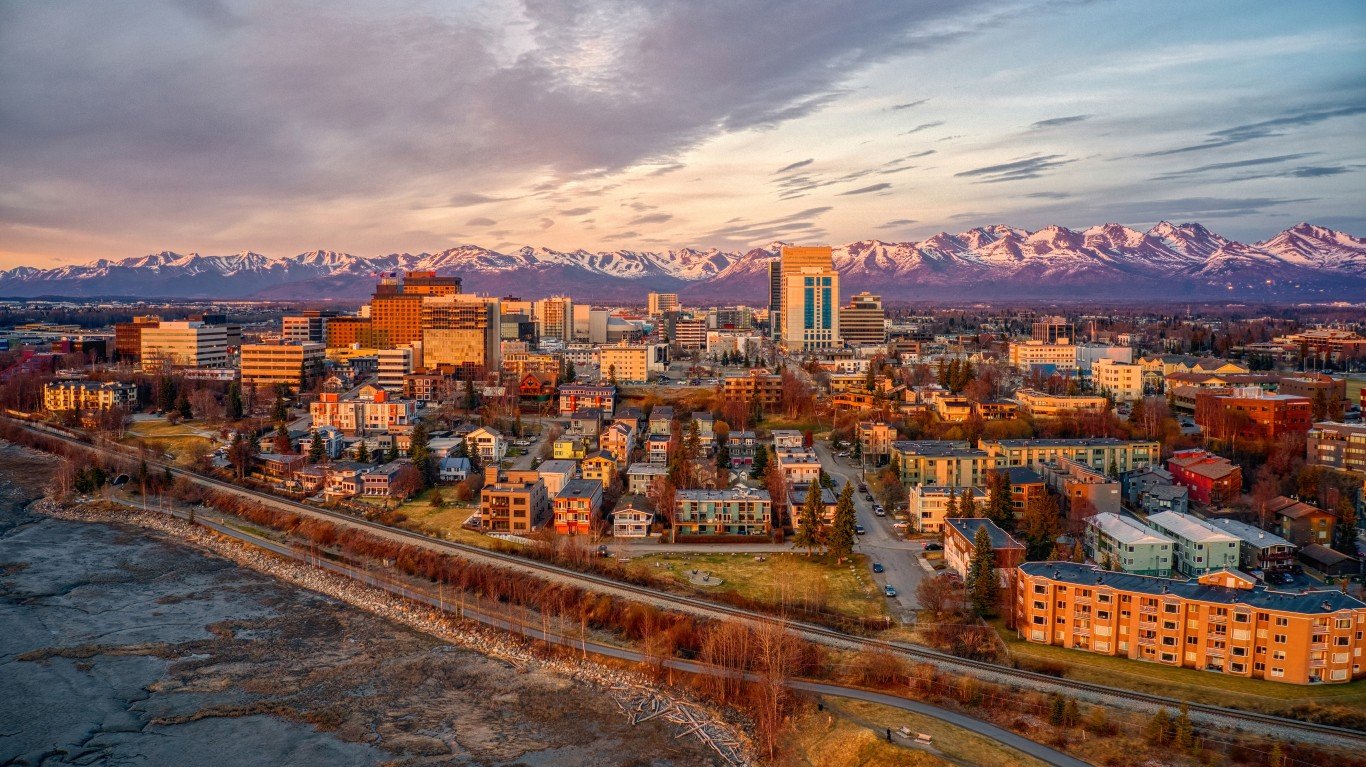

The U.S. job market has faced a historic labor shortage in recent months. With unemployment rates hovering near historic lows in much of the country, employers are struggling to fill critical positions. And the situation is not improving in most of the country.
Nationwide, there were 11.2 million unfilled jobs in July 2022, nearly 200,000 more than there were the previous month, according to a recent report from the Bureau of Labor Statistics. The worsening labor shortage is attributable to several broad trends, including reduced immigration, mass retirements, and surging quit rates – disruptions that emerged alongside the COVID-19 pandemic. (Here is a look at the states where workers are most likely to burn out.)
Still, in some parts of the country, labor market conditions this summer did not follow the national trend. In 17 states, the number of job openings actually declined from June to July – welcome news for many businesses, but bad news for job seekers.
24/7 Wall. St. reviewed July job opening data from the BLS in all 50 states to determine the states where job openings are disappearing. Among the 17 states on this list, the number of unfilled jobs fell by as much as 19% from the end of June 2022 to the end of July 2022.
Despite the falling number of job openings, employers in some states on this list are still up against massive labor shortages. In seven of these states, the share of jobs that were unfilled at the end of July exceeded the national share of 6.9%. (Here is a look at the cities projected to add the most jobs by 2060.)
Whether or not hiring will continue to outpace job growth in these states remains to be seen, but low unemployment rates in many of them will present a major challenge for employers going forward. In the majority of states on this list, the July unemployment rate was lower than the 3.5% national average.
Click here to see states where job openings are disappearing right now.
Click here to see our detailed methodology.

17. Georgia
> Change in job openings, June 2022-July 2022: -0.2% (1,000 fewer open jobs)
> Total job openings at the end of July 2022: 439,000 (8.4% of all jobs)
> July 2022 unemployment: 2.8% (150,178 people)
> Labor force size: 5,285,689 people
[in-text-ad]

16. Missouri
> Change in job openings, June 2022-July 2022: -0.5% (1,000 fewer open jobs)
> Total job openings at the end of July 2022: 214,000 (6.8% of all jobs)
> July 2022 unemployment: 2.5% (77,923 people)
> Labor force size: 3,055,883 people

15. New Hampshire
> Change in job openings, June 2022-July 2022: -2.0% (1,000 fewer open jobs)
> Total job openings at the end of July 2022: 50,000 (6.8% of all jobs)
> July 2022 unemployment: 2.0% (15,002 people)
> Labor force size: 766,697 people

14. Ohio
> Change in job openings, June 2022-July 2022: -2.0% (9,000 fewer open jobs)
> Total job openings at the end of July 2022: 438,000 (7.4% of all jobs)
> July 2022 unemployment: 3.9% (223,482 people)
> Labor force size: 5,794,695 people
[in-text-ad-2]

13. Oklahoma
> Change in job openings, June 2022-July 2022: -2.3% (3,000 fewer open jobs)
> Total job openings at the end of July 2022: 130,000 (7.1% of all jobs)
> July 2022 unemployment: 2.9% (54,916 people)
> Labor force size: 1,879,867 people

12. Louisiana
> Change in job openings, June 2022-July 2022: -2.5% (4,000 fewer open jobs)
> Total job openings at the end of July 2022: 155,000 (7.5% of all jobs)
> July 2022 unemployment: 3.7% (76,876 people)
> Labor force size: 2,104,515 people
[in-text-ad]

11. New Jersey
> Change in job openings, June 2022-July 2022: -2.8% (8,000 fewer open jobs)
> Total job openings at the end of July 2022: 273,000 (6.1% of all jobs)
> July 2022 unemployment: 3.7% (172,113 people)
> Labor force size: 4,666,387 people

10. North Carolina
> Change in job openings, June 2022-July 2022: -3.3% (12,000 fewer open jobs)
> Total job openings at the end of July 2022: 348,000 (6.8% of all jobs)
> July 2022 unemployment: 3.4% (171,657 people)
> Labor force size: 5,115,079 people

9. Texas
> Change in job openings, June 2022-July 2022: -3.3% (34,000 fewer open jobs)
> Total job openings at the end of July 2022: 985,000 (6.8% of all jobs)
> July 2022 unemployment: 4.0% (589,205 people)
> Labor force size: 14,584,437 people
[in-text-ad-2]

8. Wisconsin
> Change in job openings, June 2022-July 2022: -5.5% (12,000 fewer open jobs)
> Total job openings at the end of July 2022: 208,000 (6.6% of all jobs)
> July 2022 unemployment: 3.0% (93,408 people)
> Labor force size: 3,135,489 people

7. Massachusetts
> Change in job openings, June 2022-July 2022: -5.7% (18,000 fewer open jobs)
> Total job openings at the end of July 2022: 299,000 (7.5% of all jobs)
> July 2022 unemployment: 3.5% (130,897 people)
> Labor force size: 3,765,479 people
[in-text-ad]

6. Alaska
> Change in job openings, June 2022-July 2022: -7.1% (2,000 fewer open jobs)
> Total job openings at the end of July 2022: 26,000 (7.7% of all jobs)
> July 2022 unemployment: 4.5% (16,299 people)
> Labor force size: 361,861 people

5. Maine
> Change in job openings, June 2022-July 2022: -8.0% (4,000 fewer open jobs)
> Total job openings at the end of July 2022: 46,000 (6.7% of all jobs)
> July 2022 unemployment: 2.8% (19,317 people)
> Labor force size: 678,646 people

4. Kansas
> Change in job openings, June 2022-July 2022: -9.9% (10,000 fewer open jobs)
> Total job openings at the end of July 2022: 91,000 (6.1% of all jobs)
> July 2022 unemployment: 2.4% (36,809 people)
> Labor force size: 1,505,413 people
[in-text-ad-2]

3. Vermont
> Change in job openings, June 2022-July 2022: -11.5% (3,000 fewer open jobs)
> Total job openings at the end of July 2022: 23,000 (7.1% of all jobs)
> July 2022 unemployment: 2.1% (6,989 people)
> Labor force size: 335,605 people

2. Arkansas
> Change in job openings, June 2022-July 2022: -14.0% (14,000 fewer open jobs)
> Total job openings at the end of July 2022: 86,000 (6.1% of all jobs)
> July 2022 unemployment: 3.3% (44,613 people)
> Labor force size: 1,356,042 people
[in-text-ad]

1. Pennsylvania
> Change in job openings, June 2022-July 2022: -19.0% (83,000 fewer open jobs)
> Total job openings at the end of July 2022: 354,000 (5.6% of all jobs)
> July 2022 unemployment: 4.3% (275,137 people)
> Labor force size: 6,445,754 people
Methodology
To determine the states where job openings are disappearing, 24/7 Wall St. reviewed the Job Openings and Labor Turnover Survey report from the Bureau of Labor Statistics. States are ranked by the percent change in the number of open jobs between June 2022 and July 2022.
Job openings are the number of positions – full-time, part-time, seasonal, short-term, or permanent – open on the last business day of a given month. In order to be counted as open, the job must be an existing position that could start within 30 days and for which the employer is actively recruiting.
Figures on unemployment and labor force size, which includes employees either working or actively looking for work, are also from the BLS.
Sponsored: Find a Qualified Financial Advisor
Finding a qualified financial advisor doesn’t have to be hard. SmartAsset’s free tool matches you with up to 3 fiduciary financial advisors in your area in 5 minutes. Each advisor has been vetted by SmartAsset and is held to a fiduciary standard to act in your best interests. If you’re ready to be matched with local advisors that can help you achieve your financial goals, get started now.
Thank you for reading! Have some feedback for us?
Contact the 24/7 Wall St. editorial team.
 24/7 Wall St.
24/7 Wall St.


